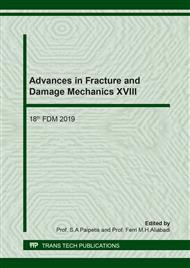p.367
p.373
p.379
p.385
p.392
p.397
p.404
p.410
p.416
Crack Initiation Mechanism of Hydrogen Induced Cracking in Nickel
Abstract:
Cracks are induced during hydrogen charging in Nickel. We have reported that the cracks initiate near the boundary between nickel matrix and nickel hydride formed near the surface by hydrogen charging. The driving force is considered to be residual stress caused by hydride formation. In the present paper, the stress distribution has been calculated near the boundary using Finite element method to clarify the crack initiation mechanism. As a result, the high-stress area corresponded to the area where the cracks were observed in the experiment.
Info:
Periodical:
Pages:
392-396
Citation:
Online since:
December 2019
Authors:
Keywords:
Price:
Сopyright:
© 2020 Trans Tech Publications Ltd. All Rights Reserved
Share:
Citation:


